Past Year Questions: Construction Materials & Construction Management | Construction Materials & Management - Civil Engineering (CE) PDF Download
Q1: The table shows the activities and their durations and dependencies in a project. [GATE CE 2024 SET-2]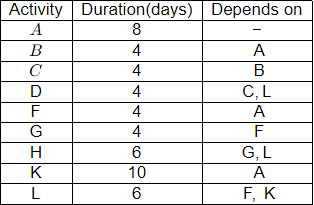
The total duration (in days) of the project is ____(in integer)
Ans: 30 to 30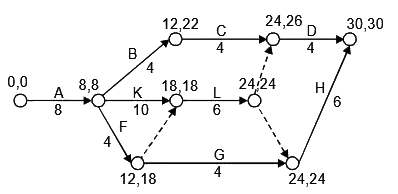 Critical path:
Critical path:
A-K-L-H
Project duration = 30 days
Q2: A critical activity in a project is estimated to take 15 days to complete at a cost of Rs. 30,000. The activity can be expedited to complete in 12 days by spending a total amount of Rs. 54,000. Consider the statements P and Q.
P : It is economically advisable to complete the activity early by crashing if the indirect cost of the project is Rs. 8,500 per day.
Q: It is economically advisable to complete the activity early by crashing, if the indirect cost of the project is Rs. 10,000 per day.
Which one of the following options is CORRECT? [GATE CE 2024 SET-2]
(a) Both P and Q are TRUE
(b) P is TRUE and Q is FALSE
(c) Both P and Q are FALSE
(d) P is FALSE and Q is TRUE
Ans: (a)
C/s = (54000-30000)/(15-12) = 8000Rs/ day
⇒ If C/s is less than indirect cost per day then it would be economically advisable to complete the activity early by crashing. Hence both the statements P and Q are correct.
Q3: Consider teh following data for a project of 300 days duration.
Budgeted cost of work scheduled (BCWS) = Rs. 200
Budgeted cost of work performed (BCWP) = Rs. 150
Actual cost of work performed (ACWP) = Rs. 190
The 'schedule variance' for the project is [GATE CE 2024 SET-2]
(a) (-)Rs. 50
(b) (-)50 days
(c) (+)Rs. 50
(d) (+)50 days
Ans: (a)
Schedule variance = BCWP − BCWS
= 150 - 200 = -50
Q4: Consider the statements P and Q.
P : In a Pure project organization, the project manager maintains complete authroity and has maximum control over the project.
Q: A matrix organization structure facilitates quick response to changes, conflicts, and project needs.
Which one of the following options is CORRECT? [GATE CE 2024 SET-2]
(a) Both P and Q are TRUE
(b) P is TRUE and Q is FALSE
(c) Both P and Q are FALSE
(d) P is FALSE and Q is TRUE
Ans: (a)
P: In a pure project organization, the project manager has the complete authority and control over the project.
Q: In a matrix organization, employees have more than one boss and work on multiple teams. This leads to quick response to changes, conflicts and project needs.
Q5: The initial cost of an equipment is Rs. 1,00,000. Its salvage value at the end of accounting life of 5 years is Rs. 10,000. The difference in depreciation (in Rs.) computed using 'double-declining balance method' and 'straight line method' of depreciation in Year-2 is ____ (in positive integer) [GATE CE 2024 SET-1]
Ans: 6000 to 6000
Given:
Initial cost, Ci = Rs. 1,00,000
Salvage value, Cs = Rs. 10,000
Useful life, n = 5 years
Straight line method,
Depreciation, 
= Rs. 18,000
As per double declining method,
Fixed factor, FDDB = 2/n = 2/5 = 0.4
∴ Book value, D1 = FDDB x Ci = 0.4 x 1,00,000 = 40,000 Rs
B1 = Rs. 1,00,000 − Rs. 40,000 = Rs. 60,000
D2 = FDDB x B1 = 0.4 x 60,000
= Rs. 24,000
∴ Difference in depreciation = Rs. 24,000 − Rs. 18,000 = Rs. 6000
Q6: Consider the statements P and Q
P: Client's Preliminary Estimate is used for budgeting costs toward the end of planning and design phase.
Q: Client's Detailed Estimate is used for controlling costs during the execution of the project
Which one of the following options is CORRECT? [GATE CE 2024 SET-1]
(a) Both P and Q are TRUE
(b) P is TRUE and Q is FALSE
(c) Both P and Q are FALSE
(d) P is FALSE and Q is TRUE
Ans: (a)
During the planning and design phase of a construction project, the client's preliminary estimate is often used as a basis for budgeting costs. Hence statement P is true.
During the execution phase of a construction project, the clients detailed estimate which is a refined and updated version of the preliminary estimate is used for controlling costs. Hence statement Q is true.
Q1: The activities of a project are given in the following table along with their durations and dependency.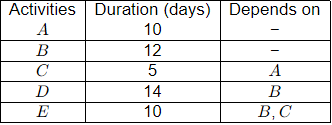
The total float of the activity E (in days) is ________. (in integer) [GATE CE 2022 SET-2]
Ans: 1 to 1 For activity E,
For activity E,
Total float  = 26 − 15 − 10 = 1 day
= 26 − 15 − 10 = 1 day
Q2: The project activities are given in the following table along with the duration and dependency. Which one of the following combinations is correct? [GATE CE 2022 SET-1]
Which one of the following combinations is correct? [GATE CE 2022 SET-1]
(a) Total duration of the project = 22 days, Critical path is Q → S
(b) Total duration of the project = 20 days, Critical path is Q → T
(c) Total duration of the project = 22 days, Critical path is P → T
(d) Total duration of the project = 20 days, Critical path is P → R
Ans: (a)  Critical path are Q-S and Q-T = 22 days
Critical path are Q-S and Q-T = 22 days
Q1: An equipment has been purchased at an initial cost of Rs. 160000 and has an estimated salvage value of Rs. 10000. The equipment has an estimated life of 5 years. The difference between the book values (in Rs, in integer) obtained at the end of 4th year using straight line method and sum of years digit method of depreciation is _____ [GATE CE 2021 SET-2]
Ans: 20000 to 20000
Initial Cost (P) = 1,60,000
Salvage value (SV) = 10,000
Useful life (n) = 5 Year
Straight Line Method:
Annual depreciation (D),
Book value after 4 year (BV4) = P − 4D = 1,60,000 − 4(30,000) = 40,000
SOY Method (Sum of year Digit)
D1 = (1,60,000 − 10,000) × (5/15)
= 50,000
d2 = 4/15; D2 = 40,000
d3 = 3/15; D3 = 30,000
d4 = 2/15; D4 = 20,000
d5 = 2/15; D2 = 10,000
BV0 = 1,60,000
BV1 = 1,60,000 - 50,000 = 1,10,000
BV2 = 1,10,000 - 40,000 = 70,000
BV3 = 70,000 - 30,000 = 40,000
BV4 = 40,000 - 20,000 = 20,000
BV5 = 20,000 - 10,000 = 10,000
Difference of book value obtained in two methods = 40,000 - 20,000 = 20,000
Q2: The activity details for a small project are given in the Table.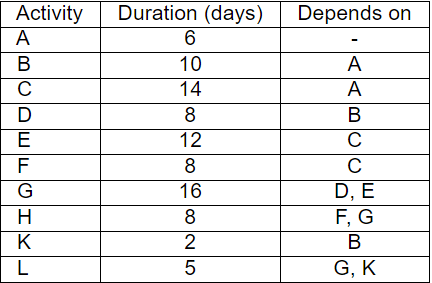 The total time (in days,in integer) for project completion is ________ [GATE CE 2021 SET-2]
The total time (in days,in integer) for project completion is ________ [GATE CE 2021 SET-2]
Ans: 56 to 56 Project duration = 56 days.
Project duration = 56 days.
Q3: In case of bids in Two-Envelop System, the correct option is [GATE CE 2021 SET-2]
(a) Technical bid is opened first
(b) Financial bid is opened first
(c) Both (Technical and Financial) bids are opened simultaneously
(d) Either of the two (Technical and Financial) bids can be opened first
Ans: (a)
Option 1 technical bid is opened first
Opening of Tender
First technical bid is opened and after ensuring that all the technical aspects of a contractor are in order than only financial bid is opened
1. Envelope 1 ( Technical bid )
(i) Cover letter
(ii) Registration Details
(iii) Pre-qualification documents
(iv) Earnest money deposit
(v) Assumptions & Deviations in making of tender
(vi) Drawings
2. Envelope 2 (Financial Bid)
(i) Forms of tender
Q4: Seasoning of timber for use in construction is done essentially to
(a) increase strength and durability
(b) smoothen timber surfaces
(c) remove knots from timber logs
(d) cut timber in right season and geometry
Ans: (a)
Option 1 Increase strength and durability.
The process of drying of timber is known as seasoning.
Natural tree has more the 50% weight of water of its dry weight.
If we directly use this timber the because of irregular drying internal stresses will develop between fibres of timber and it will develop lots of defects (warps, shakes etc).
Q5: A small project has 12 activities - N, P, Q, R, S, T, U, V, W, X, Y, and Z. The relationship among these activities and the duration of these activities are given in the Table.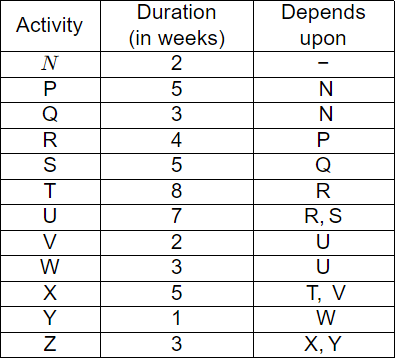 The total float of the activity 'V' (in weeks, in integer) is _________ [GATE CE 2021 SET-1]
The total float of the activity 'V' (in weeks, in integer) is _________ [GATE CE 2021 SET-1]
Ans: 0 to 0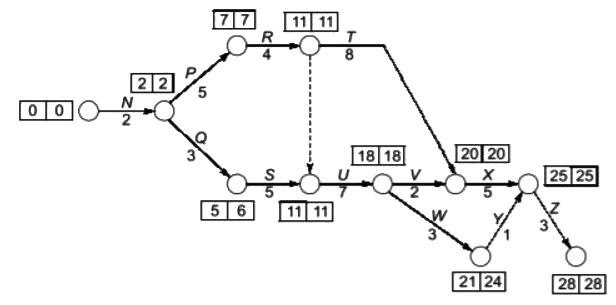
 = 20 − 18 − 2
= 20 − 18 − 2
= 0
Q6: Contractor X is developing his bidding strategy against Contractor Y. The ratio of Y's bid price to X's cost for the 30 previous bids in which Contractor X has competed against Contractor Y is given in the Table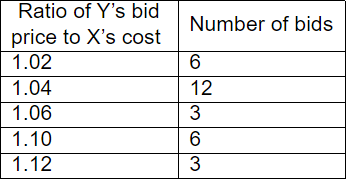 Based on the bidding behaviour of the Contractor Y, the probability of winning against Contractor Y at a mark up of 8% for the next project is [GATE CE 2021 SET-1]
Based on the bidding behaviour of the Contractor Y, the probability of winning against Contractor Y at a mark up of 8% for the next project is [GATE CE 2021 SET-1]
(a) 0%
(b) more than 0% but less than 50%
(c) more than 50% but less than 100%
(d) 100%
Ans: (b)
Markup is 8%
By general understanding of normal distribution table.
Corresponding to Z = 0.647 and 8% mark up we get probability of 0.2668 = 26.68%
Which is more than 0% bu less tahn 50%.
Q7: The direct and indirect costs estimated by a contractor for bidding a project is Rs.160000 and Rs.20000 respectively. If the mark up applied is 10% of the bid price, the quoted price (in Rs.) of the contractor is [GATE CE 2021 SET-1]
(a) 200000
(b) 198000
(c) 196000
(d) 182000
Ans: (a)
Direct Costs = 160000
Indirect costs = 20000
Mark up applied is 10% of the Bid price
Bid price = Direct cost + Indirect cost + Markup
Bid price = Direct cost + Indirect cost + (10/100) x Bid price
Bid price (1 − (10/100)) = DC/IC
Bid price = (160000+20000)/0.9 = 2,00,000
Q8: Gypsum is typically added in cement to [GATE CE 2021 SET-1]
(a) prevent quick setting
(b) enhance hardening
(c) increase workability
(d) decrease heat of hydration
Ans: (a)
The Gypsum is added to cement at the end of grinding clinker it is added to prevent quick setting.
Q1: A box measuring 50 cm x 50 cm x 50 cm is filled to the top with dry coarse aggregate of mass 187.5 kg. The water absorption and specific gravity of the aggregate are 0.5% and 2.5, respectively. The maximum quantity of water (in kg, round off to 2 decimal places) required to fill the box completely is ____. [2019 : 2 Marks, Set-I]
Ans: Volume of box = 0.5 × 0.5 × 0.5 = 0.125 m3

Volume (V) = Vc + Vw
Volume of coarse aggregates 

Volume of water = V – Vc = 0.125 – 0.075 = 0.05 m3
Water absorption is 0.5%

Total weight of water = volume × γw + weight of water absorbed
= 0.05 × 1000 + 0.9375 = 50.9375 kg
Q2: The network of a small construction project awarded to a contractors is shown in the following figure. The normal duration, crash duration, normal cost and crash cost of all the activities are shown in the table. The indirect cost incurred by the contractor in I NR 5000 per day. [2019 : 2 Marks, Set-1]
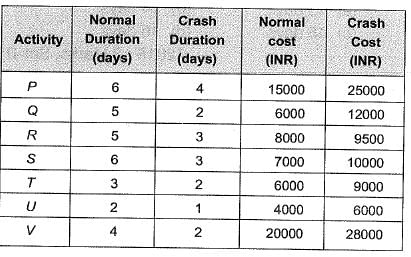
If the project is target for completion in 16 days, the total cost (in INR) to be incurred by the contractor would be_______.
Ans: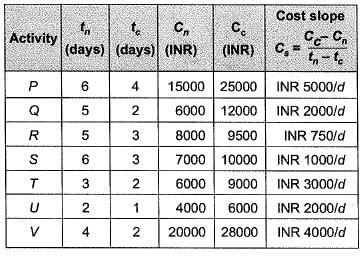
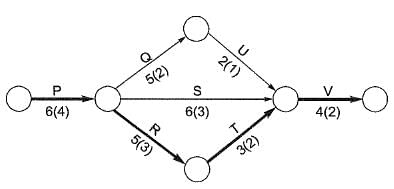
Considering normal durations, the total cost of the project
TC = DC + IC
= INR 66000 + INR 5000 x 18
= INR 156000
Stage-I: Crash activity R by 1 day
∴ Project becomes
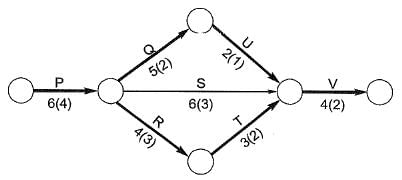
TC = (INR 6600 + INR 750) + INR 5000 x 17
= 151750
Stage-II: Crash activity Q&R (or U&R) by 1 day
∴ Project becomes
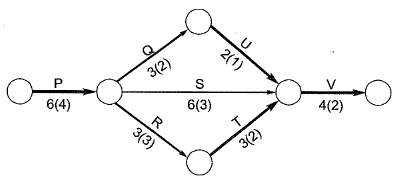
TC = (INR 66750 + INR 2000 + INR 750) + (INR 5000 x 16)
= 149500
Q1: The setting time of cement is determined using [2018 : 1 Mark, Set-II]
(a) Le Chatelier apparatus
(b) Briquette testing apparatus
(c) Vicat apparatus
(d) Casagrande’s apparatus
Ans: (c)
Vicat apparatus is used to determine:
(i) Consistency, the percentage of water required to preparing cement pastes for other tests by the help of plunger of length 50 mm and diameter 10 mm.
(ii) Initial setting time, by the help of square needle of cross-section 1 mm x 1 mm.
(iii) Final setting time, by the help of the needle with annular collar
Q2: The Le Chatelier apparatus is used to determine [2018 : 1 Mark, Set-I]
(a) compressive strength of cement
(b) fineness of cement
(c) setting time of cement
(d) soundness of cement
Ans: (d)
Le Chatelier Apparatus is used to determine the soundness of cement as per IS code 4031 (part 3); this cement testing procedure is called Le Chatelier test for determining the unsoundness properties of cement due to presence of “free lime”.
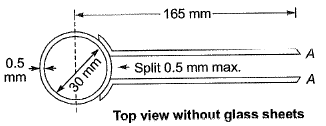
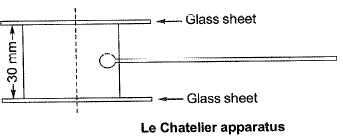
Q1: Consider the following statements: [2017 : 2 Marks, Set-II]
P. Walls of one brick thick are measured in square meters.
Q. Walls of one brick thick are measured in cubic meters.
R. No deduction in the brickwork quantity is made for openings in walls up to 0.1 m2 area.
S. For the measurement of excavation from the borrow pit in a fairly uniform ground, deadman are left at suitable intervals.
For the above statements, the correct option is
(a) P-False; Q-True; R-False; S-True
(b) P-False; Q-True; R-False; S-False
(c) P-True; Q-False; R-True; S-False
(d) P-True; Q-False; R-True; S-True
Ans: (d)
1. One brick wall → 20 cm (Nominal thickness)
2. 1.5 brick wall → 30 cm (Nominal thickness)
3. 2 brick wall → 40 cm (Nominal thickness)
where “Nominal thickness” is considered for measuring of wall work.
• Brick wall is measured in m2 is the brick wall thickness is 10 cm (half brick wall) and 20 cm (full brick wall/one brick wall) and for brick wall greater than one brick wall i.e., 1.5 or 2 brick wall. The brick wall is measured in m3.
• No deduction for openings and bearings in masonry works is made when
(a) opening each upto 1000 sq. cm or 0.1 m2
(b) ends of beam, post, rafters upto 500 sq./m or 0.05 m2
(c) Bed plate, wall, plate, bearing of balcony (chajja) and like upto 10 cm depth, bearing of floor and roof slab are not deducted from masonry.
As per 151200 (Part-I) : 1992, “deadmen and tell tales” in borrow pits is not measured separately and its removal is done after measurement.
Q2: Group I gives a list of test methods and test apparatus for evaluating some of the properties of Ordinary Portland Cement (OPC) and concrete. Group II gives the list of these properties [2017 : 2 Marks, Set-II]

The correct match of the items in Group I with the items in Group II is
(a) P-1, Q-3, R-4, S-2
(b) P-2, Q-3, R-1, S-4
(c) P-4, Q-2, R-4, S-1
(d) P-1, Q-4, R-2, S-3
Ans: (a)
Q2: For a construction project, the mean and standard deviation of the completion time are 200 days and 6.1 days, respectively. Assume normal distribution and use the value of standard normal deviate, z = 1.64 for the 95% confidence level. The maximum time required (in days) for the completion of the project would be _____. [2017 :1 Mark, Set-II]
Ans: Expected completion time of project,
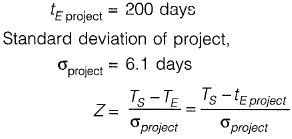
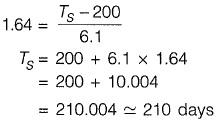
Q3: Given that the scope of the construction work is well-defined with all its drawings, specifications, quantities and estimates, which one of the following types of contract would be most preferred? [2017 : 1 Mark, Set-II]
(a) EPC contract
(b) Percentage rate contract
(c) Item rate contract
(d) Lump sum contract
Ans: (c)
Percentage rate Contract: In this form of contract, the displacemente draws up 'Item rate tender' i.e., bill of quantities with-rate, amount and total amount. The contractors are required to offer to carry out the work as per the rates shown in the specifi price schedule or some percenrage above or some percentage below the rates indicated in the shedule of work attached with the tender.
Item rate contract: In this a contract under takes the execution of work on an item rate basis. He is required to quote rate for individual item of work o the basis of shedule of quantities i.e., BOQ furnished by the department.
Lumpsum concract: In this type, a contractor is required to quote a fixed sum for execution of work complete in all respect in the stipulated time according to the drawing, design and specification supportd to him with the tender. In item rate contract, contractor only fill its rate against given item and its quantity and contract does not change the item make, drawing, specification during construction without consent of owner/department.
Item rate contract is also called “unit price contract” where contractor bids cost per unit of each item. These works are carried out in accordance with contract documents. The contractor has to perform the quantities of the work actually required in the field at his quoted unit prices, whether they are less or greater than “owner/department” estimates.
Q4: The activity details of a project are given below: [2017 : 2 Marks, Set-I]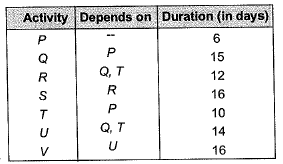
The estimated minimum time (in days) for the completion of the project will be _____ .
Ans: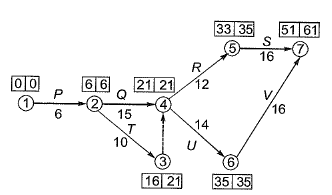
Note: Path of longest duration is defined as the critical path as the activities lying in this path are called critical activities. Any delay in these activity will lead to delay in overall project. The project time given by critical path. Hence the time taken by the critical path is the shortest possible time to finish the project.
Critical Path → P - Q - U - V
Tcp = 6 + 15 + 14 + 16 = 51 days
Q1: As per Indian standards for bricks, minimum acceptable compressive strength of any class of burnt clay bricks in dry state is [2016 : 1 Mark, Set-11]
(a) 10.0 MPa
(b) 0.75 MPa
(c) 5.0 MPa
(d) 3.5 MPa
Ans: (d)
As per IS 1077 : 1992 clause 4.1 , minimum strength of burnt clay bricks is 3.5 MPa. The bricks with crushing strength of 7 to 14 N/mm2 are graded as A and those having above 14 N/mm2 are graded as AA
Q2: The compound which is largely responsible for initial setting and early strength gain of Ordinary Portland Cement is [2016 : 1 Mark, Set-I]
(a) C3A
(b) C3S
(c) C2S
(d) C4AF
Ans: (b)
Properties of the Bogue’s compounds:
C3A:
- The reaction of C3A with water is very fast.
- It may lead to an immediate stiffening of paste, and it is called flash set.
- To prevent this flash, 2-3% gypsum is added at a time of grinding cement clinker,
- The hydrated C3A do not contribute to the strength of the concrete
C3S
- It is responsible for early strength.
- First 7 days strength is due to C3S
- It produces more heat of hyudration.
- A cement with more C3S content is better for cold weather concreting.
C2S:
- The hydration of C2S starts after 7 days.
Hence it gives strength after 7 days. - C2S hydrates and hardens slowly and provides much of the ultimate strength.
- It is responsible for the later strength of the concrete.
- It produces less heat of hydration.
C4AF:
- C4AF hydrates rapidly.
It does not contribute to strength of the concrete
Q3: Bull’s trench kiln is used in the manufacturing of [2016 : 1 Mark, Set-I]
(a) lime
(b) cement
(c) bricks
(d) none of these
Ans: (c)
Bull trench kiln is a continuous kiln generally oval in plan. It is 50 to 100 m long and 1.5-2.5 m deep below ground level. It is divided into 8-12 sections which is used for manufacturing of bricks.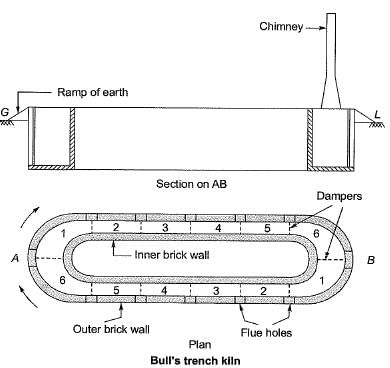
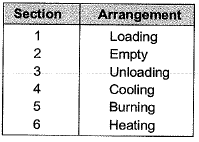
Q4: The activity-on-arrow network of activities for a construction project is shown in the figure. The durations (expressed in days) of the activities are mentioned below the arrows. [2016 : 2 Marks, Set-II]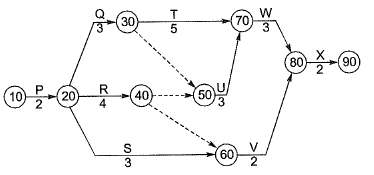
The critical duration for this construction project is
(a) 13 days
(b) 14 days
(c) 15 days
(d) 16 days
Ans: (c)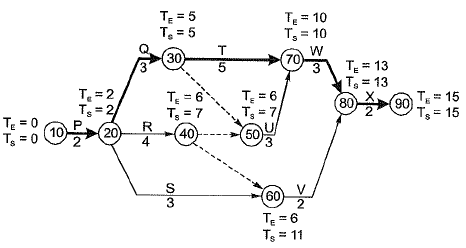
The critical duration is 15 days which is observed along the path P-Q-T-W-X which is the critical path of the project.
Note: Critical path is the one which consumes maximum amount of time.
Q5: The Optimistic Time (O), Most likely Time (M) and Pessimistic Time (P) (in days) of the activities in the critical path are given below in the format O-M-P. [2016 : 2 Marks, Set-I]
The expected completion time (in days) of the project is __________
Ans:
Q6: A construction project consists of twelve activities The estimated duration (in days) required to complete each of the activities along with the corresponding network diagram is shown below. [2016 : 1 Mark, Set-II]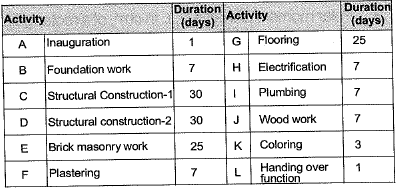

Total floats (in days) for the activities 5-7 and 11-12 for the project are, respectively,
(a) 25 and 1
(b) 1 and 1
(c) 0 and 0
(d) 81 and 0
Ans: (c)
Total float can be determined once the activity times i.e. EST, EFT, LST and LFT are known.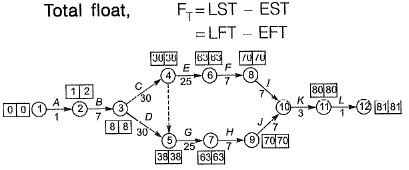
For activity 5-7,
For activity 11-12,
Note: It can be seen directly that since the slack of all events are zero, there is not margin left for the occurence of events and therefore.
Maximum available line = Time required for completion of activity
∴ FT for all activities is zero.
Q1: The composition of an air-entrained concrete is given below [2015 : 2 Marks, Set-I]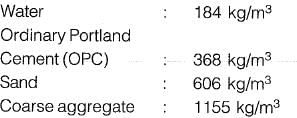
Assume the specific gravity of OPC, sand and coarse aggregate to be 3.14, 2.67 and 2.74 respectively. The air content is________liters/m3.
Ans: Let the total volume of air-entrained concrete is unity.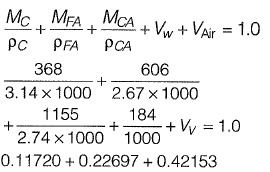

|
5 videos|29 docs|16 tests
|
FAQs on Past Year Questions: Construction Materials & Construction Management - Construction Materials & Management - Civil Engineering (CE)
| 1. What are the most common types of construction materials used in building projects? |  |
| 2. How do construction materials impact sustainability in building projects? |  |
| 3. What is the role of construction management in ensuring quality materials are used? |  |
| 4. How can construction managers effectively select materials for a project? |  |
| 5. What are some challenges faced in sourcing construction materials? |  |
















